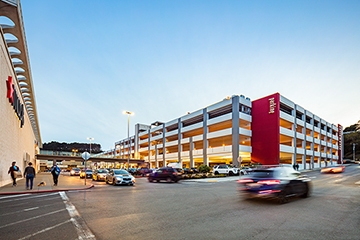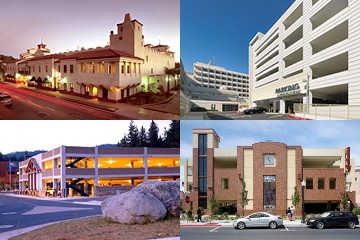The Benefits of Understanding the Parking Lifecycle

We often think of structured parking as a process that begins with design and ends with the opening of a new facility. However, the parking lifecycle starts at the earliest planning stages of a project, whether expanding a campus, designing an entirely new development, or redeveloping an existing area. Once the facility is complete, proper care and maintenance can significantly improve the user experience, extend its life and reduce future retrofit and repair costs.
Understanding the full parking lifecycle not only helps owners integrate parking more effectively, but also make the most out of that investment.
 Early master planning and feasibility studies aid owners in determining the location, size and impact of structured parking.
Early master planning and feasibility studies aid owners in determining the location, size and impact of structured parking.
Stage 1: Early Planning
The first stage of the parking lifecycle is early planning. As parking is often a key driver in determining the success and size of a larger project, establishing how much parking is needed, where it should be located and how much it will cost can dramatically affect the overall design. Addressing these questions in early planning helps avoid complications and can save time and money during the design and construction process.
How much parking is needed? Supply and demand studies can help determine how much parking is needed to support your project. When integrating parking into mixed-use projects, shared parking studies can help ensure adequate parking is provided without overbuilding.
Where should parking be located? Early master planning and feasibility studies aid owners in determining the location, size and impact of structured parking. Identifying site constraints, circulation patterns and effect on surrounding land use provides valuable information to ensure your parking is well-integrated into the final design.
How much will it cost? Budget is a critical factor when planning for structured parking. Beyond the basics, such as stall count, how many levels and whether parking will be above grade or subterranean, major cost factors include the structure’s location, the extensiveness of architectural detailing, and so on. To make things even more complex, material and labor costs can vary considerably based on geography, are market driven, and can have a significant impact on the bottom line. Understanding of the critical elements that affect the construction cost of a parking structure can help you budget for the parking you need.
 The growing popularity of electric vehicles increase the demand for charging infrastructure.
The growing popularity of electric vehicles increase the demand for charging infrastructure.
Stage 2: Parking Design
Parking design is perhaps the most familiar stage of the parking lifecycle. Ensuring the parking facility you envision meets your needs and those of its users involves a number of design considerations. In addition to ramping floor plates, traffic considerations, openness considerations and pedestrian safety, parking poses a number of unique challenges, including:
Sustainable Design: Per the USGBC, stand-alone parking structures are not eligible for LEED certification. However, Parksmart is a USGBC rating system designed specifically for parking structures. Parksmart Certified parking experts can assist you in designing to Parksmart or Parksmart equivalent goals and guide you through the certification process.
Electric Vehicle Charging: Electric vehicle sales are at an all-time high and continue to gain popularity, which in turn increases the demand for charging infrastructure. From meeting current code guidelines to understanding the different types of charging stations to managing electrical load and efficiency, it’s important to understand the current challenges posed by EV charging technology and how to navigate them.
Mechanical & Automated Parking: In an increasing number of urban areas, site constraints such as limited footprints, height restrictions, the cost of subterranean excavations, etc. can make mechanical and automated parking solutions a more cost effective design alternative. However, determining the value these solutions can provide is a complex question that requires careful consideration of a number of different factors aside from the cost of a particular system. Parking experts with extensive experience designing these solutions should be involved in the earliest stages of design to achieve the best results.
 Developing both short and long-term maintenance and improvement plans can maximize the lifespan of your parking facility.
Developing both short and long-term maintenance and improvement plans can maximize the lifespan of your parking facility.
Stage 3: Ongoing Maintenance
The parking lifecycle continues long after a parking facility opens. Protecting your parking investment with proper care and maintenance not only extends the facility’s lifespan and reduces future retrofit and repair costs, but also ensures the user experience continues to provide that valuable positive first impression. Developing both short and long-term maintenance and improvement plans can maximize the lifespan of your parking structure.
Ongoing Maintenance Plan: While much can be done during the initial design to enhance the durability of concrete structures and minimize maintenance, parking facilities require regular upkeep. An ongoing maintenance plan that includes routine sweeping, pressure washing and regular visual inspections by a facility manager can pay long-term dividends by keeping the structure friendly and pleasing to users, as well as identifying potential issues before they require more extensive repairs.
Capital Improvement Plans: In addition to establishing a detailed cleaning and regular maintenance plan with daily, weekly, monthly, quarterly, semi-annual and annual tasks, a capital improvement plan can further protect your parking investment. An important part of this plan is regular condition assessments starting when the structure is 5-10 years old. In addition to identifying any structural issues that could affect a facility’s lifespan, condition assessments can also identify safety concerns that may impact users.
Parking is a significant investment. Therefore, whether designing for a campus, mixed-use development, higher education, municipal downtown or multi-modal hub, being mindful of parking’s role throughout the lifecycle of early planning, design and construction and ongoing maintenance can help you get the most out of it.








